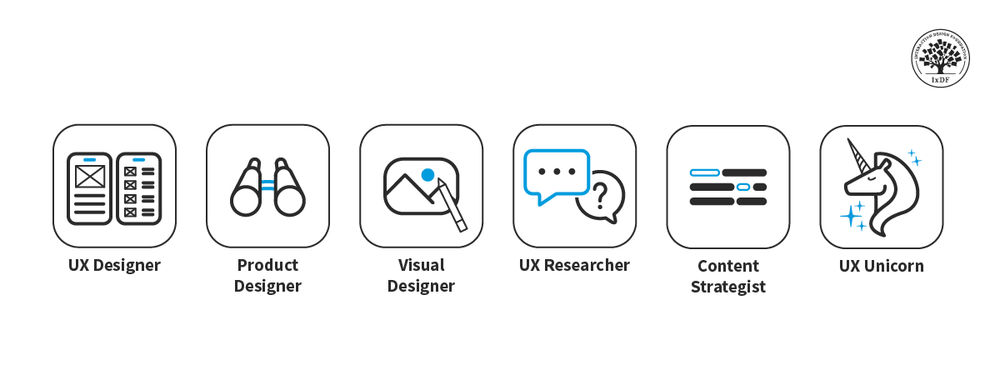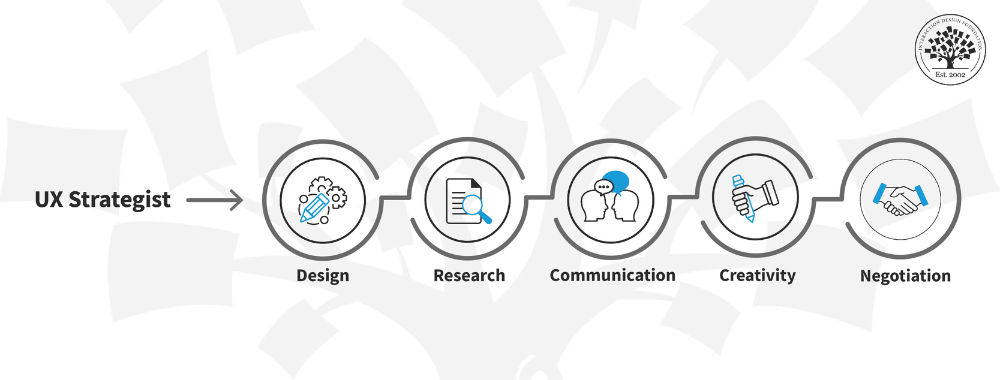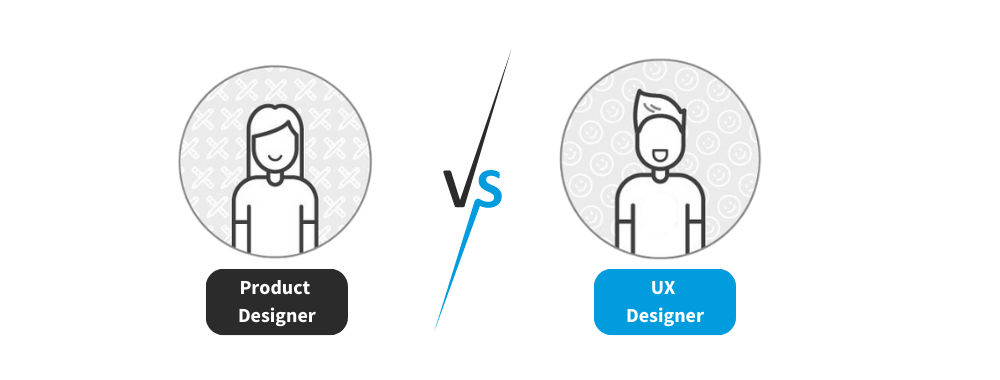UX Roles: The Ultimate Guide – Who Does What and Which One You Should Go For?

- 1.1k shares
- 2 mths ago
UX roles describe the various parts designers play in the design process. They range from generalist roles—e.g., UX designers and product designers—to specialist ones such as visual designers and UX researchers. UX roles might overlap in scope, and they keep evolving with our understanding of the ideal design process.
“Successful design projects require effective collaboration and healthy conflict.”
—Dan M. Brown, Author, co-founder and principal of EightShapes
© The Interaction Design Foundation, CC BY-SA-NC 3.0.
Watch a discussion about generalist versus specialist roles in the world of user experience (UX) design.
One major part of what a design team does is to follow a user centered design process and work through it to produce the best possible designs for the target users. Team-mates perform many tasks throughout projects—from user research[TTV3] , to prototyping, to conducting usability testing—to iterate towards optimal solutions. Design thinking showcases the key UX tasks corresponding to these roles. It also reflects how each role contributes slightly differently regarding tasks. Main roles are:
1. UX designers (akaInteraction/UI/Experience designers) – Generalists working on all design thinking phases.
Tasks:
Conduct UX research
Find users’ pain points
Generate ideas through, e.g., worst possible idea
Choose the best ideas
Offer/accept critique on possible solutions
Prototype
Conduct usability testing
Release the most beneficial design
Typical Deliverables:
Paper prototypes
High-fidelity, pixel-perfect mock-ups
Reports: usability, user research, heuristic evaluation and user testing
Design pattern libraries, style guides or design systems
2. Product designers – Like UX designers, but focusing especially on product design and the UX. They help create product designs, goals and roadmaps (high-level summaries/6–12-month forecasts of product offerings and features).
Tasks:
(Same as UX designers’)
Inform and plan roadmaps
Collaborate closely with development and marketing teams to ensure designs can be implemented properly
Typical Deliverables:
(Same as UX designers’)
Product roadmaps (probably co-developing these alongside other stakeholders)
3. Visual designers – Specialists with graphic design/visual design backgrounds focusing on making pixel-perfect prototypes later in the design process.
Tasks:
Convert UX goals into attractive design sets (e.g., app screens) with high usability and accessibility
Create and/or maintain libraries of product icons, colors and fonts
Apply branding guidelines
Utilize design concepts (e.g., Gestalt principles) to make pleasing graphical user interfaces (GUIs)
Typical Deliverables:
Prototypes: pixel-perfect and interactive
Visual style guides
Icon libraries
Design specifications for frontend developers to produce needed live code
Branding materials or guidelines supplementing each product
4. User/UX researchers – Researchers interested in human psychology, focusing on understanding and advocating for users.
Tasks:
Understand users deeply through qualitative research
Develop realistic understandings of specific user traits through quantitative research
Analyze gathered user data to synthesize key findings and make design proposals
Advocate to other internal stakeholders for users’ needs and perspectives
Help inform product goals by presenting research findings to relevant internal stakeholders
Test and improve designs using evaluative research – e.g., usability testing
Typical Deliverables:
User personas
“How might we” statements
Reports: user research, usability, heuristic evaluation and user testing
5. Content strategists – Skilled in copywriting to create persuasive, clear, consistent copy (during prototyping) to appear directly on products.
Tasks:
Write copy so users can navigate, use and troubleshoot user-interface products easily
Create effective page titles and navigation menu item names so users can intuitively access desired pages/screens
Write simple, effective and blame-free error messages to assure users
Craft effective emails and newsletters to achieve product goals
Weave cohesive narratives throughout products to express a consistent tone of voice and direction for users
Define and maintain a vision for each product’s language for across-the-board application
Typical Deliverables:
Copy (incorporated into products)
Editorial/product language guidelines, setting each product’s tone and content style
6. UX unicorns (aka UX engineers) – A rare breed handling UX design and frontend development.
Tasks:
(Same as UX designers’)
Develop live frontend prototypes for realistic usability testing
Implement frontend code
Typical Deliverables:
(Same as UX designers’)
Frontend prototypes
Ready-for-launch frontend code
 Author/Copyright holder: Yuval Yeret. Copyright terms and licence: CC BY-NC-SA 3.0
Author/Copyright holder: Yuval Yeret. Copyright terms and licence: CC BY-NC-SA 3.0
Organizations’ definitions of UX roles vary. While these shouldn’t deviate drastically from those listed above, you should research a brand’s culture to understand its expectations. For instance, recruiters scanning UX portfolios may want a “UX designer” to handle all UX-related tasks. Applicants would then address that in their UX cover letters and UX resumes. Also, with the industry’s dynamic nature, expect to constantly find new job titles, job descriptions and UX tools. Nonetheless, your knowledge remains timeless – you just must adapt to whatever hat your company wants you to wear.
Take our UX Portfolio course to understand which UX roles fit whom.
Skillcrush staff writer Scott Morris offers many insights on UX roles.
For fascinating observations, read senior industrial designer Per Magnus Skold’s approach to UX roles.
UX (user experience) design involves a range of roles that focus on creating useful, usable, and delightful digital experiences. The main roles in UX design include:
UX Designers shape the overall user experience by researching user needs and crafting intuitive interfaces. They create wireframes and prototypes, ensuring smooth and logical user interactions. They also organize content and navigation so users can find what they need easily.
UI Designers focus on the look and feel, choosing colors, typography, and visual layout.
UX Researchers gather data about user behaviors and needs through interviews, surveys, and usability tests.
UX Writers craft microcopy and interface text that guides and supports users.
Product Designers often blend UX, UI, and strategy to align user needs with business goals.
These roles frequently overlap in practice, especially in small teams or small organizations. Each plays a vital part in shaping engaging, user-centered digital products.
Watch this revealing video about important points to bear in mind when deciding on which UX role to go for:
© The Interaction Design Foundation, CC BY-SA-NC 3.0.
Explore an immense landscape of career possibilities in the Build a Standout UX/UI Portfolio: Land Your Dream Job course with Morgane Peng: Designer, speaker, mentor, and writer who serves as Director and Head of Design at Societe Generale CIB.
Interaction designers fit into UX teams by focusing on the behavior of digital products—how users move through a system and how interfaces respond. They ensure interactions are intuitive, efficient, and aligned with user goals. While UX designers often handle a broader scope (including user research and overall experience), interaction designers dive deep into the details of usability and flow.
In many UX teams, especially smaller or cross-functional ones, a UX designer may perform interaction design tasks. In larger teams, interaction designers often work alongside visual designers, UX researchers, and developers, turning insights and wireframes into interactive prototypes or behavior specs.
Their role bridges design and development: they help translate user needs and design intentions into interactions that feel natural. Interaction designers improve how users engage with digital products, often shaping whether those experiences feel seamless or frustrating.
Watch to learn some important points about what an interaction designer does:
Take the Build a Standout UX/UI Portfolio: Land Your Dream Job course with Morgane Peng: Designer, speaker, mentor, and writer who serves as Director and Head of Design at Societe Generale CIB.
Yes; switching from graphic design to UX design is not only possible—it’s common, too. Graphic designers already have a solid foundation in visual communication, layout, and branding, all of which carry over directly into UI and UX work. What you'll need to add are skills in user research, interaction design, usability principles, and prototyping.
Many graphic designers start by learning UX fundamentals through courses or hands-on projects. They often pivot into UI design roles first and then expand into broader UX responsibilities. Your eye for detail, creative problem-solving, and ability to design visually appealing interfaces already give you a head start.
To ease the transition, build a UX-focused portfolio with case studies that highlight your design thinking, not just aesthetics. Focus on user flows, problem statements, and testing outcomes.
Explore more insights in our piece about this subject: How to Change Your Career from Graphic Design to UX Design.
Explore the rich tapestry of elements that make up UX design in this video:
Yes; there is a difference between a service designer and a UX designer—but they often collaborate and their work overlaps.
A UX designer typically focuses on digital experiences: how users interact with a website, app, or system. They optimize usability, flow, and interaction within that digital context.
A service designer, on the other hand, maps and improves the entire service journey—across digital and physical touchpoints. This could include call centers, in-store experiences, logistics, and backend operations. Service designers look at the full ecosystem, not just the screen.
The key difference lies in scope. UX design usually focuses on digital product interactions. Service design zooms out to orchestrate how all components—tech, people, spaces, and policies—work together to deliver a seamless service.
In practice, many UX designers apply service design principles, especially in complex or omnichannel environments. After all, “users” and “experience” feature as vital focal points in both UX design and service design.
Watch as CEO of Experience Dynamics, Frank Spillers discusses service design:
Enjoy our Master Class Going from UX to Service Design with Frank Spillers.
No; you don’t need a degree to work in a UX role. Most UX hiring managers focus more on your portfolio, skills, and thinking than on formal education. Many successful UX professionals come from non-traditional backgrounds—graphic design, psychology, coding, writing, even architecture.
What matters most is that you understand user-centered design principles, can conduct or interpret research, and know how to design and test usable interfaces. You’ll also need to communicate design decisions clearly and collaborate well with developers and stakeholders.
You can build these skills through online UX courses, bootcamps, or self-study—and then apply them in personal projects, freelance work, or internships. A strong, well-documented portfolio often carries more weight than a degree, especially if it shows your process and problem-solving.
Explore the journey from one trade to UX design in our piece How to Change Your Career from Marketing to UX Design.
Follow another journey into UX design in our piece, I’m a business manager. How do I become a UX designer? for valuable insights.
UX roles collaborate closely with developers and product managers to ensure products are both user-friendly and feasible to build. UX designers bring user insights and prototypes to the table. Product managers define business goals and priorities. Developers evaluate what’s technically possible and help bring designs to life.
Together, they form a cross-functional team that balances usability, business needs, and engineering constraints. UX designers often join product discovery early, shaping feature ideas based on user research. Throughout development, they refine designs with developer input and test usability. Testing is essential from early prototypes to final design solutions.
Effective collaboration hinges on clear communication. UX designers must explain design decisions with user evidence, while adapting to tech realities. Shared tools like design systems, user stories, and agile rituals (like sprint planning and retros) keep everyone aligned.
Yes; UX is a strong, future-resilient career. Demand for UX professionals remains high because businesses now understand that thoughtful design drives user satisfaction, loyalty, and growth. UX roles consistently rank well for job satisfaction, pay, and career opportunities.
However, with AI reshaping how professionals work, the nature of UX work will evolve. AI may handle routine tasks like layout generation, A/B test analysis, or user data clustering. What it won’t replace is the human side—empathy, storytelling, ethics, and strategic thinking. UX designers who focus on those skills will stay essential.
As technology grows more complex, companies need designers who can make it feel seamless and human. That is why UX careers span every industry, from fintech and health tech to education and government. UX also offers room to grow into roles in leadership, research, content, or service design.
Explore the journey from one trade to UX design in our piece I’m a business manager. How do I become a UX designer? for valuable insights.
Discover more insights in another journey into UX design in our piece How to Change Your Career from Marketing to UX Design.
A UX strategist defines the long-term user experience vision and aligns it with business goals. While UX designers focus on the “how”—creating screens, flows, and interactions—UX strategists focus on the “why” behind product decisions. They connect user needs, brand values, and market trends to guide design efforts at a strategic level.
Their work involves user research, competitive analysis, stakeholder interviews, and aligning cross-functional teams around a shared UX roadmap. They help prioritize features that add value, shape KPIs for user experience, and influence the overall product direction.
In short, UX strategists ensure the product delivers real value, not just a polished interface. Their role is critical in large-scale projects, design transformations, or early-stage startups looking to build the right thing from the start.
Explore more insights in our piece What Does a UX Strategist Do?
Watch CEO of Experience Dynamics, Frank Spillers discuss UX strategy:
To become a UX lead or UX manager, you need more than design skills; you need leadership, strategy, and collaboration skills. Strong UX leads excel in communication, stakeholder management, and guiding design teams. They set the vision, mentor designers, and ensure projects align with both user needs and business goals.
Key skills include:
UX design expertise: Wireframing, prototyping, usability, and research must be second nature.
Team leadership: Delegating, giving feedback, and nurturing talent are core to the role.
Strategic thinking: You must align UX outcomes with product strategy and KPIs.
Cross-functional collaboration: You’ll bridge product, dev, and business teams.
Communication: Leading design critiques and presenting to execs requires confidence and clarity.
Most UX leads evolve into the role after years of hands-on design work and by consistently driving impact at a team level.
Discover a wealth of valuable insights in UX Management: Strategy and Tactics, and watch as Frank Spillers explains key points about the course:
In a UX team, UX researchers or UX designers typically lead user testing, depending on the team’s size and structure. In larger teams, UX researchers plan and run usability tests—choosing methods, recruiting users, and analyzing results. In smaller teams, UX designers often take the lead, using lightweight tools like moderated interviews or remote testing platforms.
Still, everyone shares a stake in user testing, and effective user testing is non-negotiable. Product managers help define what needs validating. Developers join sessions to observe pain points. Stakeholders use findings to guide decisions. It’s a collaborative effort with UX roles driving the process.
Effective teams don’t treat user testing as a phase; they embed it throughout the design cycle. This helps them catch issues early, validate ideas quickly, and build products users enjoy using.
Take our course Conducting Usability Testing.
Discover important insights in our piece 4 Common Pitfalls in Usability Testing and How to Avoid Them to Get More Honest Feedback.
Lebson, C. (2021). The UX Careers Handbook (2nd ed.). CRC Press.
The UX Careers Handbook by Cory Lebson serves as a comprehensive guide for individuals pursuing or advancing a career in user experience (UX). The second edition updates the original content with insights into critical soft skills, expanded discussions on UX leadership, and introduces a 17th UX career pathway. Lebson offers practical advice on personal branding, networking, resume and portfolio development, and strategies for securing UX positions. The book includes real-world stories from industry professionals, activities, and worksheets to aid career planning. It's an essential resource for students, career changers, hiring managers, and recruiters aiming to understand and navigate the diverse landscape of UX professions.
Buley, L. (2023). The User Experience Team of One: A Research and Design Survival Guide (2nd ed.). Rosenfeld Media.
Leah Buley’s The User Experience Team of One is an essential resource for UX professionals working solo or in small teams. The second edition expands on the original’s practical tools and methodologies for conducting user research, ideation, and design without extensive resources. Buley emphasizes lean and adaptable processes, making UX work feasible even in organizations with limited support. The book offers step-by-step guidance on integrating UX into product development, advocating for user needs, and driving UX maturity. Its relevance has only grown as UX becomes a broader discipline embraced by startups and cross-functional teams alike, making it a must-read for independent and embedded UX practitioners.
Remember, the more you learn about design, the more you make yourself valuable.
Improve your UX / UI Design skills and grow your career! Join IxDF now!
You earned your gift with a perfect score! Let us send it to you.
We've emailed your gift to name@email.com.
Improve your UX / UI Design skills and grow your career! Join IxDF now!
Here's the entire UX literature on UX Roles by the Interaction Design Foundation, collated in one place:
Take a deep dive into UX Roles with our course AI for Designers .
Master complex skills effortlessly with proven best practices and toolkits directly from the world's top design experts. Meet your expert for this course:
Ioana Teleanu: AI x Product Design Leader (ex-Miro, ex-UiPath). Founder, UX Goodies.




We believe in Open Access and the democratization of knowledge. Unfortunately, world-class educational materials such as this page are normally hidden behind paywalls or in expensive textbooks.
If you want this to change, , link to us, or join us to help us democratize design knowledge!
